Special wheel chassis "Object 1040"
In 1960, the Soviet defense industry began developing a promising air defense system with the code "Ellips" (later the project was named "Wasp"). In accordance with the task of the customer, it was necessary to create a self-propelled vehicle on a wheeled chassis, carrying its own means of detecting targets and a launcher for guided missiles. Quickly enough, the authors of the “Ellipse” project identified the main features of the future car, and also formed the requirements for the base chassis.
It should be noted that in 1960-61, the project developers had to face certain difficulties associated with finding a suitable base. It turned out that a number of existing and future armored vehicles of domestic development do not meet the requirements of the new project. Studied the development of the plant them. Likhachev, as well as the Gorky and Mytishchi automotive plants, but none of them could become the basis for the air defense system. Fortunately, there was another potential carrier of special equipment.
In 1960, the Special Design Bureau of the Kutaisi Automobile Plant, which collaborated with the Military Academy of Armored Forces, developed and built the experienced four-axle armored personnel carriers "Object 1015B." This technique was not without flaws, and besides, it had minimal chances to go into service. Nevertheless, she became interested in the context of the Ellips project. There was a proposal to finalize the existing armored personnel carrier to the needs of the anti-aircraft complex. Similar works started in 1963-64's.
SKB KAZ and related organizations had to change the project "1015B" in accordance with the updated requirements. The chassis of the new type, called "Object 1040", no longer had to carry two dozen paratroopers with weapons, the place of which should have been taken by new radio-electronic systems and other devices. On the roof of the housing to mount the proposed radar and launcher. Due to certain changes in the design of an armored personnel carrier, it was necessary to obtain a payload of at least 3,5-4 T - that is how much, according to calculations, all the new air defense system equipment weighed.
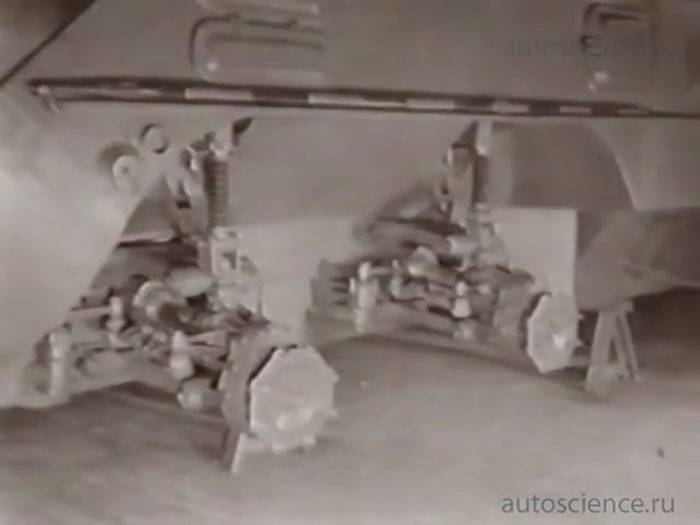
Chassis elements. Photo Autoscience.ru
The 1040 Object Project provided for the preservation of the main ideas and decisions of the previous 1015B. At the same time, it was planned to recycle all major components and assemblies in accordance with the experience of the tests carried out and taking into account the new requirements. As a result, the two cars had a number of common features, but they differed significantly from each other. In particular, two samples could be distinguished by the shape of the sides: the base armored personnel carrier had inclined sheets, while the chassis for the SAMs differed in box-shaped units.
The new project involved the assembly of a welded armored body, consisting of sheets no thicker than 8-10 mm. Through the use of curved parts, the length of the welds was reduced, and the level of protection was accordingly increased. However, the armored corps could protect the crew only from small arms bullets and light fragments. The layout of the hull was changed to reflect the new purpose of the machine. In the front part there was a manned compartment, which united the department of management and the volume to accommodate operator places or special equipment. Feed was given under the engine compartment. At the same time on the bottom of the case, under the covers, there were various transmission units.
The frontal part of the updated body has retained its characteristic shape, made up of three main large parts. The bottom large sheet had curved edges; above it was a sloping middle sheet. The top front sheet received a couple of openings for inspection hatches, and they were located at different levels. The lower part of the body, as before, had a narrowed front unit with an extended rear. At the same level with the wheels were vertical and inclined sheets. Above the chassis were large shelves of rectangular section. Above the hull was protected by a horizontal roof with two large hatches, openings for the installation of the target equipment. Vertical feed differed simplicity and consisted of several separate sheets.
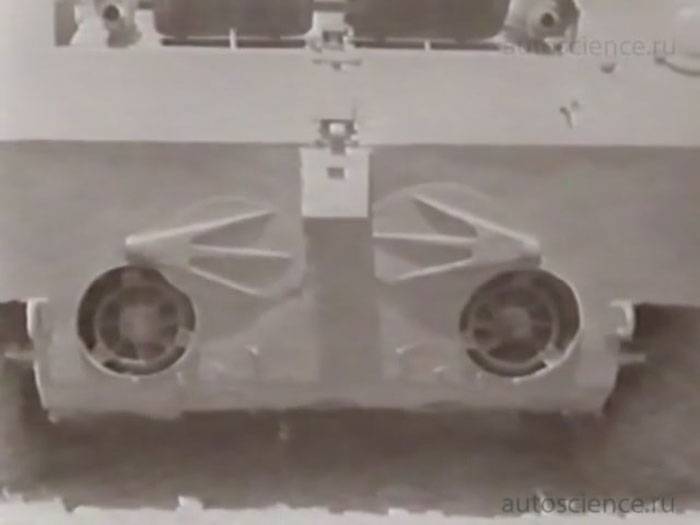
Feed water cannons, lids open. Photo Autoscience.ru
In the aft power compartment of the “1040 Object” was placed the petrol engine ZIL-375 with the power 180 hp. The engine was connected to a five-speed manual gearbox. From it, the torque entered the transfer case, located in the center of the case, with a shift back. The new project again used the H-shaped power distribution scheme. Through the on-board differential of the transfer case, the power was output to the cardan shafts connected to the onboard gears of the third axis. With them came the power of the shafts to other transmission connected with all wheels.
The power take-off was retained, with which the torque could be delivered to the jet propulsion and self-pulling winch. To the first two shaft departed, to the second - one.
An auxiliary innovation of the 1040 project was the auxiliary power unit. On the right side of the hull, in its aft part, it was proposed to place a low-power gas-turbine engine with a generator. This installation was designed to power anti-aircraft systems, including when the main engine is off.
The undercarriage of the 1015B Facility has been redesigned and improved. The two front axles retain an independent lever suspension with a hydropneumatic shock absorber. On the rear axles, similar shock absorbers were used with torsion bars. The hydraulic system as part of the suspension provided the ability to change the clearance. All the wheels had a large diameter, are connected to the central pressure control system. Two front axles were made manageable.
From the predecessor of the new chassis crossed two jet propulsion. Pipes-conduits were located in the stern of the hull and connected the holes on the bottom with the nozzles in the stern sheet. The nozzles were closed with movable dampers, by means of which the flow was also controlled. Also, the course control was carried out by turning the steering wheels.
The crew of the "Object 1040" was determined in accordance with the features of the installed equipment. Own crew chassis could consist only of the driver. Next to him in front of the corps could work commander. In the back of the habitable compartment could be placed one or two operators of anti-aircraft weapons - depending on the characteristics of the latter. At the disposal of the commander and the driver were hatches in front of the roof. It was suggested to follow the road with the help of frontal glazing, covered with armored cassettes, or periscopic devices. Operator hatches should be located in the central part of the machine.
The special chassis “1040” was originally created for the installation of units of the Ellips / Osa anti-aircraft missile system. From a certain time, the authors of both projects have been working on the original version of the placement of the target equipment. In front of the car, as well as at the level of the third axis, the seats for the two blocks of equipment should be placed on the roof. The front shoulder strap was designed for mounting a rotary launcher. In the back should be installed a similar system with radar devices.
A launcher of type 1040P9 has been developed for use on the 33 Object. All its devices were mounted on a turntable, which provided a preliminary horizontal guidance. On it were swinging launch rails for 9М33 missiles. The dimensions of the chassis allowed to equip the installation of four guides for missiles. Behind the launcher, in the central part of the roof of the chassis, it was planned to mount the gas discharge plate. With it planned to protect against the negative impact of external devices and machines hatches.
The antenna post was a system with a large box-shaped case, on which all the necessary devices were placed. It was supposed to provide the possibility of rotation in any direction with a change in the angle of inclination. At one post it was planned to place the antennas of the detection and guidance stations.
In its dimensions, the new self-propelled air defense missile system, in general, had to correspond to the base armored personnel carrier. The length and width of the car did not seriously change, but the new devices should have significantly increased its height. The combat weight was initially determined at the level of 13,5-14 t. Of these, 4,8 t accounted for the equipment of the anti-aircraft complex. According to calculations, on the highway “Object 1040” should have reached a speed of up to 80-85 km / h. The water speed was set at 8-9 km / h. Cruising on the highway - 600 km.
The use of ready-made developments and existing units allowed the Kutaisi Automobile Plant to quickly prepare equipment for testing. Already in the summer of 1964, two experienced “1040 Objects” left the assembly hall. These machines were in fact prototypes and were intended only for the study of basic design solutions. Full running trials of the chassis were supposed to be carried out only with a third prototype. The order for its construction appeared in August of the same year.
In October, the third prototype was ready for testing. During the acceptance of this car, it turned out that KAZ had violated production technologies. The curb weight of the chassis instead of the calculated 9 t was 9,7 t. Such an advantage was the real problem, since by that time the calculated mass of the SAM system had increased by about 500 kg. All this should have led to an unacceptable weighting of the combat vehicle as a whole. The customer and the contractors began to search for acceptable solutions.
At the end of November 1964, the decision was made to start the running tests of the third 1040 machine with weight payload simulators. A ballast was placed inside the hull, the weight of which corresponded to the equipment of "Wasps". A pair of metal boxes, imitating a launcher and an antenna post, were installed on the roof seats. The total mass of simulators reached 5 t. The balancing of the prototype corresponded to the calculated combat vehicle.
4 December machine with ballast came to the test. The first checks were carried out at the testing base of the Kutaisi Automobile Plant. The first stage of checks on the go with the load continued until mid-January. In early March, the “1040 Object” was delivered to the Kubinka region near Moscow, where the second stage was to be completed. New tests continued until the end of March. During the running test of the chassis with a real load simulator, it passed along various 10 routes, thousands of kilometers, and spent 10 hours on the water.
Tests have shown that in a number of indicators the prototype meets the requirements. Road performance on all routes and landscapes, in general, were acceptable. However, it was not without problems. Thus, the overweight of the car led to a reduction in the range on the highway to 445 km. The warranty period has decreased from 15 thousand km to 10 thousand km. A lot of minor flaws and technological problems associated with low production culture, a characteristic KAZ problem, were identified. However, they could be eliminated in the future, after the launch of mass production.
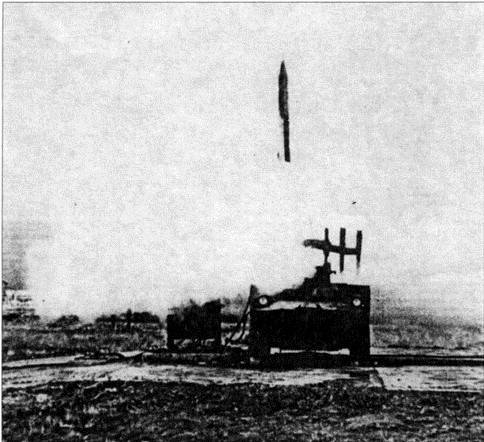
Rocket launch. Photo Denisovets.ru
SKB KAZ claimed that the main cause of the identified problems lies in the excessive mass of the machine and insufficient engine power. These problems were proposed to be solved with the help of a modified version of the project called “1040B Object”. Such a machine was supposed to be equipped with a ZN-133 engine with 220 horsepower. while maintaining the existing transmission. In addition, they decided to develop a new building for it. While maintaining all the basic features, it had to be built from aluminum. Armored steel remained only as protection for crew jobs.
Also the participants of the program “Wasp” expressed other suggestions. In their opinion, it was possible to increase the characteristics due to the banal observance of production technologies, or by reducing the requirements for the machine. However, the implementation of such proposals took time, and work continued with the existing prototype.
In the middle of 1966, the third prototype of the 1040 Object chassis was equipped with a full set of equipment of the new anti-aircraft complex. Already during the first launches of missiles, it was determined that the machine did not fully meet its objectives. During the launch, the missiles deviated from the desired trajectory, which made it difficult to control their flight. As it turned out, this was due to the buildup of the launcher and machine as a whole. Having ensured sufficient rigidity of the whole structure with the help of improvised braces, the testers obtained the desired flight profile.
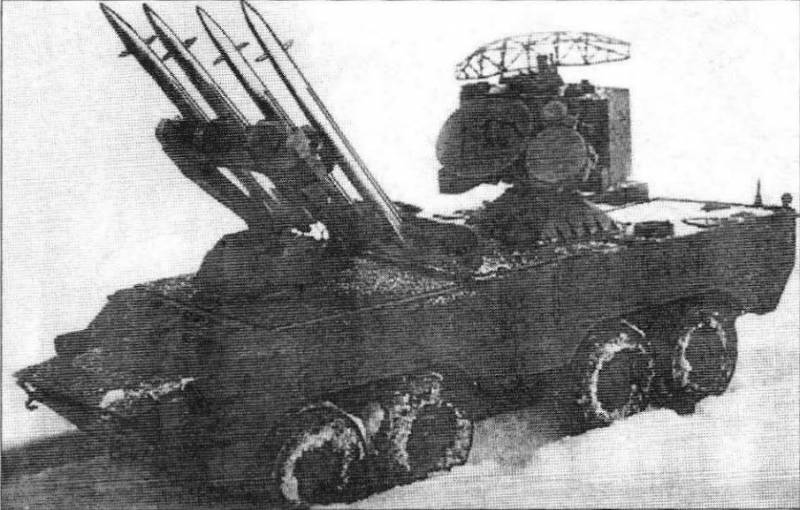
A retouched photograph of a real prototype showing the final appearance of the OSA "Osa" air defense system on the "1040 Object" chassis. Photo Ru-papertanks.livejournal.com
Various tests of an experimental air defense system built on the Kutaisi chassis lasted for two years. The results of the checks were mixed. The characteristics and capabilities of the missile system gradually improved, and the base chassis of the 1040 type regularly showed its new flaws. As a result of this, it was decided to involve the Bryansk Automobile Plant, which was also able to design and build the required chassis, to work on the Osa theme.
In July, 1968, the commission of the customer, who oversaw the development of a new anti-aircraft complex, made its decision. In the act of testing noted characteristic flaws of the combat vehicle in the proposed form, which did not allow to take it into service. Claims to the chassis related to insufficient driving characteristics associated with exceeding the permissible weight. In addition, the layout with the separated installation of the launcher and the antenna post proved to be unsuccessful. It did not allow for circular targeting without turning the entire vehicle and thereby reducing the combat effectiveness of the complex.
Soon the Ministry of Defense made its decision. The development program of the OSA "Osa" was supposed to continue. The troops needed a short-range anti-aircraft complex, and the results obtained were encouraging. However, now the complex should have been mounted on a different chassis. Especially for the solution of this problem, BAZ began the development of the “Object 937” machine. The process of creating a completely new chassis took some time, but still had the desired final.
In 1970, the Soviet industry launched the production of the 3K33 Osa serial air defense systems on the BAZ-5937 chassis. Over the next two decades, 1200 combat vehicles of several modifications were built on the same Bryansk-made chassis. At present, the Osa family systems remain the most massive military air defense systems in the Russian army. Thus, the project BAZ-5937 fully justified itself.
As for the “Object 1040” project, it was closed no later than the end of 1968. It was developed specifically for the Ellips / Osa air defense system and had no prospects apart from this project. Choosing a new chassis for the "Wasp" put an end to the Kutaisi development. In addition, it was decided to abandon the further development of existing developments. New projects based on 1015B or 1040 have not been worked out. KAZ Special Design Bureau has returned to the projects of civil automobile equipment. First of all, it continued the development of the Kolhida truck family.
Information about the future of the three prototypes built "Object 1040" no. At the same time, it is known that none of these machines did not live up to our time. Apparently, after closing the project, they got rid of unnecessary equipment in the most rude way. The prototype chassis "1040B", as far as is known, was not built. The fourth prototype of a car with an armored hull was also not completed and was not tested.
In the late fifties of the last century, the Kutaisi Automobile Plant was attracted to the development of promising models of armored vehicles. For several years, the company, collaborating with other organizations, developed and tested two versions of an armored personnel carrier, offered a couple of projects for wheeled infantry fighting vehicles and brought up the landing gear test for the air defense system, and then offered its modified version. None of these projects has progressed further to field testing of experimental machines. The equipment did not receive recommendations for serial production and for adoption. However, it cannot be said that such an outcome was unacceptable. Samples of armored combat vehicles, adopted instead of the objects "1015", "1020" and "1040", by all the main parameters exceeded the equipment from Kutaisi.
Based on:
http://denisovets.ru/
http://pvo.guns.ru/
Korovin V. The Osa anti-aircraft missile system. // Technique and weapons, 2010. No.7-8.
Solyankin A. G., Pavlov M. V., Pavlov I. V., Zheltov I. G. Domestic armored vehicles. XX century. - M .: Exprint, 2010. - T. 3. 1946 – 1965.
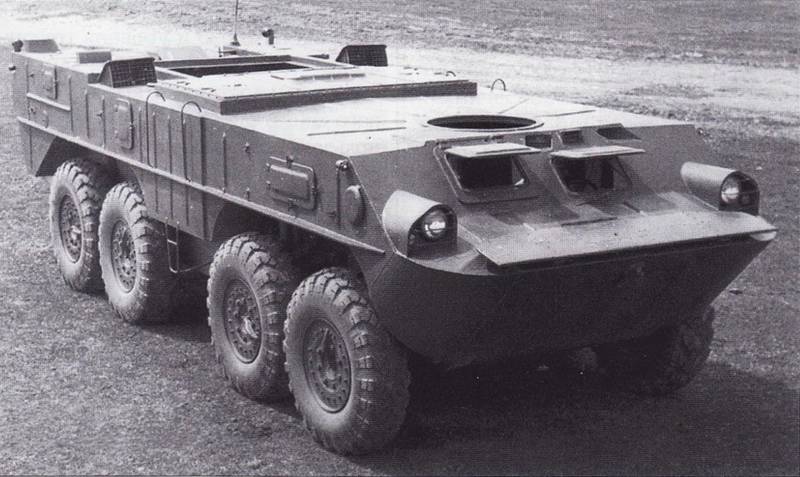
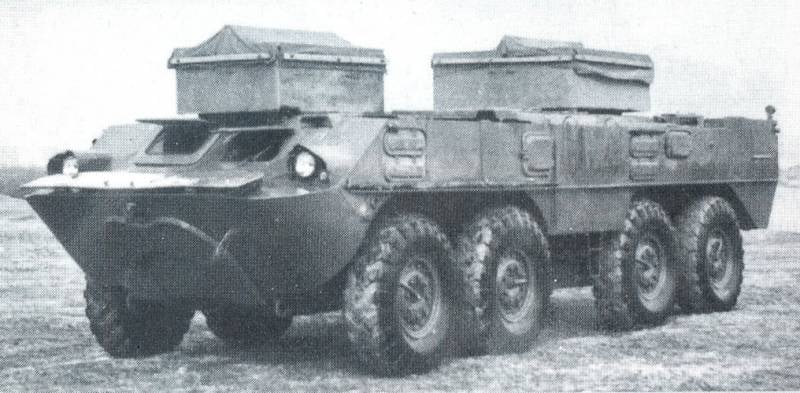
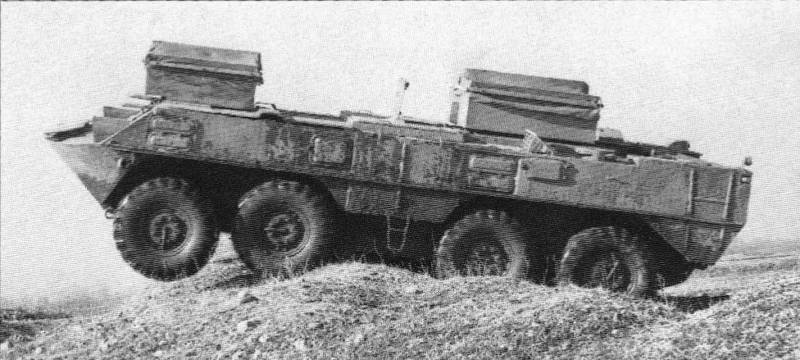
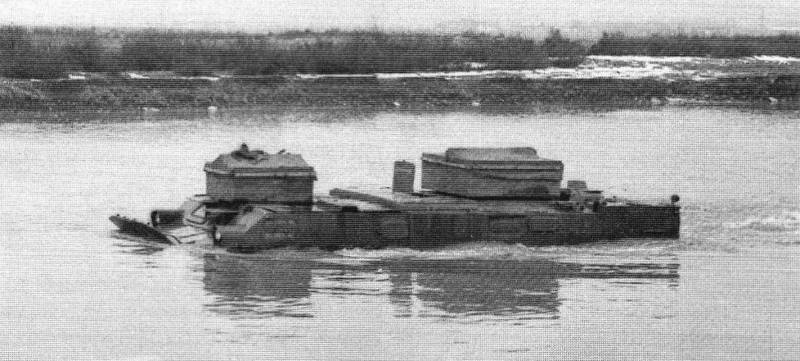
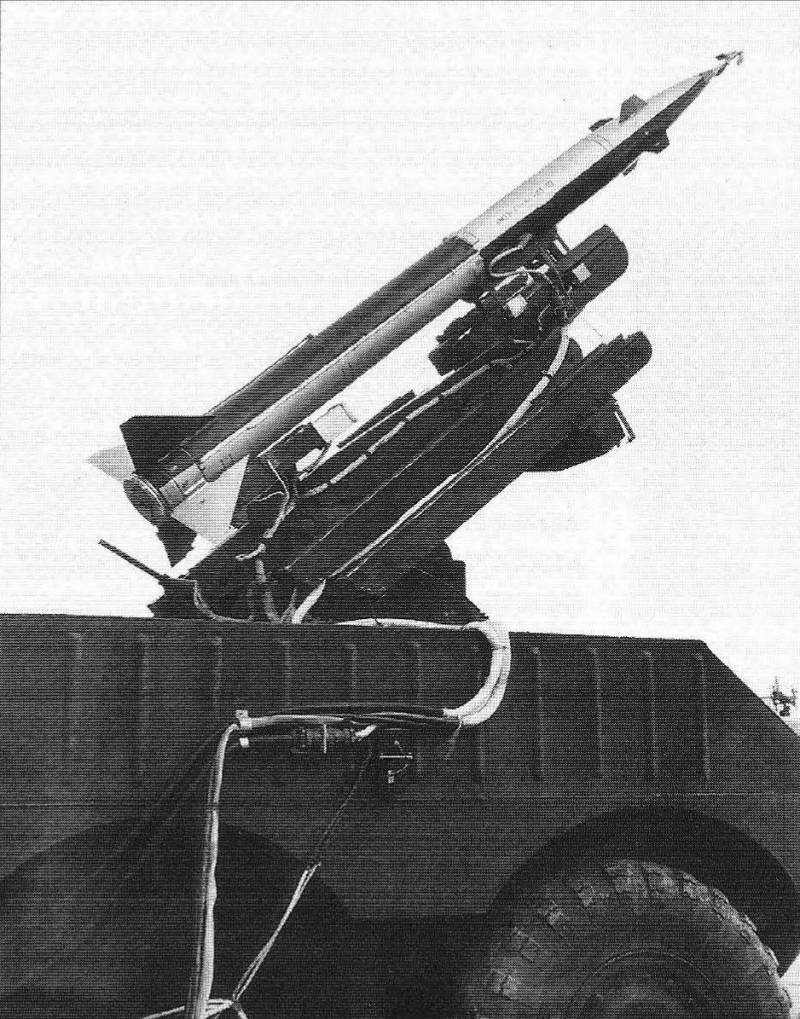
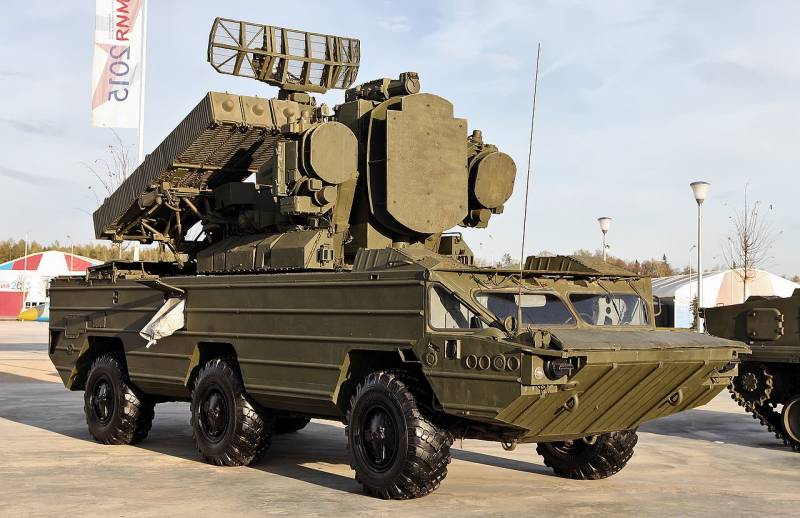
Information